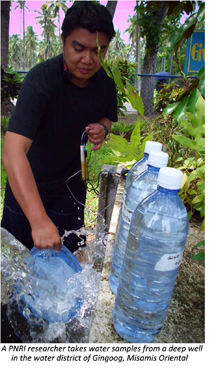
Capitalizing on the unique advantage of nuclear technology, the Philippines joins the world in providing better access to clean and safe drinking water as it takes a pioneering role in the International Atomic Energy Agency (IAEA) Water Availability Enhancement Project, or IWAVE.
The Philippines is the first Member State of the IAEA to participate in the project, followed by Oman and Costa Rica. IWAVE aims to build capacity in these Member States and assist them in gathering and using scientific information to fully assess the availability and quality of water resources, contributing to the United Nations Millennium Development Goal of halving the number of people worldwide without access to clean drinking water by 2015.
The Department of Science and Technology – Philippine Nuclear Research Institute (DOST-PNRI) implements the I-WAVE project in collaboration with the National Water Resources Board (NWRB), the Department of Environment and Natural Resources – Mines and Geosciences Bureau (DENR-MGB) and other water-based agencies.
In 2011, PNRI, NWRB and MGB, with contributions from other water agencies, began developing a Philippine Hydrological Gap Plan which agrees to fill the technology, expertise, infrastructure and investments needed. The report entitled “Investment Needs for Resource Assessment Capability in the Philippines to Improve the Planning and Management of Water Infrastructure” was completed in August 2012 and published the following month.
An adequate national assessment of water sources is the first and vital step in making these resources more accessible. Assisting the MGB project on Groundwater Resources and Vulnerability Assessment of the Philippines (GRVAP), the IAEA and PNRI lent their expertise in the design and application of isotope hydrology techniques with data analysis and interpretation in Water Resources Regions (WRR) 2 and 10 through a Technical Contract. The project covers the provinces of Cagayan, Isabela, Nueva Viscaya and Quirino in Region 2, and Bukidnon, Misamis Oriental, Dinagat Islands, Surigao Del Norte, Agusan Del Sur and Agusan Del Norte in Region 10. The water districts in these municipalities are collaborating in the endeavor.
The isotope hydrology approaches that are developed and tested will be replicated in other water critical areas which will be undertaken within the 2014-2015 IAEA Technical Cooperation project “Intergrating Isotope Techniques for Increasing Effectiveness in Water Assessment and Management.”
With corresponding support under the IWAVE project, capacity building activities to address identified priority gaps have been implemented, with some still underway. These include conducting national workshops where appropriate international experts were invited and training courses on the application of hydrological tools toimprove water resources assessment.












































